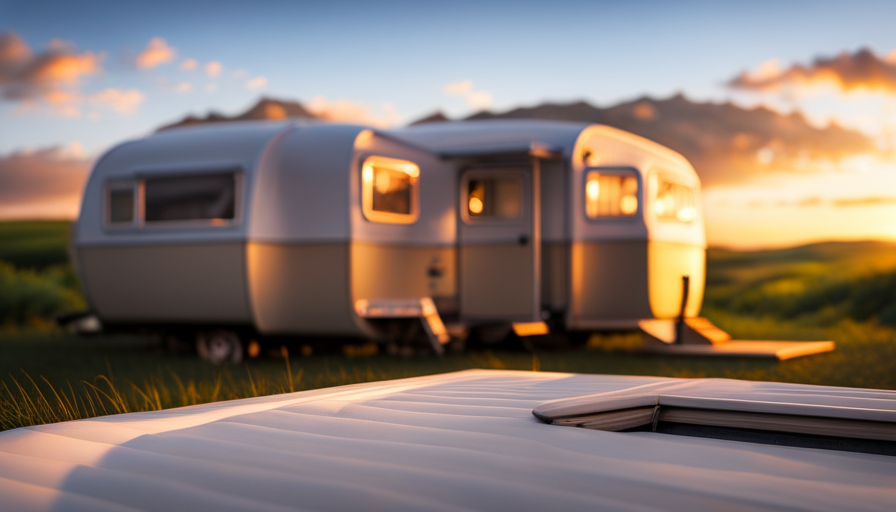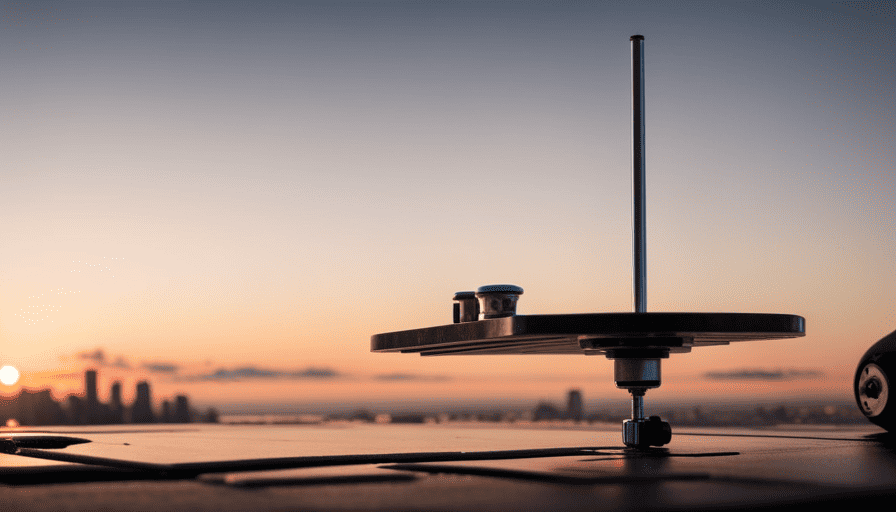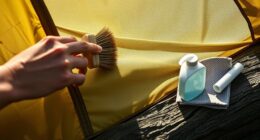Imagine stepping into your RV and immediately feeling surrounded by safety and warmth. The walls around you act as a protective barrier, keeping you safe from the outside world and providing a cozy sanctuary as you journey. These partitions aren’t just obstacles; they are the foundation of your mobile home.
But have you ever wondered what exactly camper walls are made of?
Like the pieces of a puzzle, each material used in constructing camper walls serves a specific purpose, fitting together to create a sturdy and reliable structure. From the lightweight and durable fiberglass to the strength and resistance of aluminum, the choices are vast. Composite panels offer a balance of strength and insulation, while wood, with its insulation properties, remains a traditional favorite.
To ensure optimal insulation, styrofoam and foam insulation are used between panels, accompanied by plywood as a strong and sturdy base. Laminates add a decorative touch, available in various patterns and colors. Adhesives and sealants bond and seal the components, providing added durability and weather resistance.
In this article, we will delve into the fascinating world of camper walls, exploring the materials that make them so exceptional and the role each one plays in creating a secure and comfortable haven on your travels.
Key Takeaways
- Camper walls can be made of various materials such as fiberglass, aluminum, composite panels, wood, and vinyl.
- Fiberglass is a popular choice for camper walls due to its lightweight, durability, and endless design possibilities.
- Aluminum camper walls offer strength, resistance to corrosion, and can withstand harsh weather conditions, while also providing impact protection.
- Composite panels, made of fiberglass sheets and foam or honeycomb core, provide a balance of strength and insulation, making them lightweight, sturdy, and cost-effective options for camper walls.
Fiberglass: Lightweight and durable option for camper walls
Fiberglass is the go-to choice for camper walls, as it’s not only lightweight and durable, but it also allows for endless design possibilities. When comparing fiberglass to aluminum, there are pros and cons to consider.
Fiberglass is lighter in weight, making it easier to tow and maneuver on the road. Additionally, it’s more resistant to dents and scratches, ensuring that your camper walls stay looking pristine for years to come.
The installation process of fiberglass camper walls involves constructing them in layers. First, a gel coat is applied to the mold, providing a smooth and glossy finish. Then, a layer of fiberglass matting is added, which provides strength and rigidity. Finally, a layer of resin is applied to bond the matting together and create a solid structure. This construction method ensures that the camper walls are strong and durable, capable of withstanding the rigors of the road.
Transitioning to the subsequent section about aluminum, it’s worth noting that while fiberglass offers lightweight and endless design possibilities, aluminum provides strength and resistance to corrosion.
Aluminum: Provides strength and resistance to corrosion
Aluminum, like a steadfast shield, lends strength and shields against the relentless assault of corrosion. When it comes to camper walls, aluminum is a popular choice due to its durability and resistance to rust.
Here are the pros and cons of aluminum compared to fiberglass:
-
Strength: Aluminum is known for its toughness, making it a great option for camper walls. It can withstand harsh weather conditions and provides excellent protection against impacts.
-
Resistance to Corrosion: Unlike fiberglass, aluminum is highly resistant to corrosion. This means that it can withstand exposure to moisture, salt, and other corrosive elements without deteriorating over time.
-
Cost Comparison: Aluminum is generally more expensive than fiberglass. However, the long lifespan and low maintenance requirements of aluminum walls can make it a cost-effective choice in the long run.
Next, let’s explore another camper wall material that offers a balance of strength and insulation: composite panels.
Composite Panels: Offers a balance of strength and insulation
Imagine a material that combines the best of both worlds – strength and insulation, creating a fortress against the elements. Composite panels offer exactly that, making them a cost-effective solution for camper walls.
These panels are made up of two outer layers of fiberglass sheets and a core material, typically made of foam or honeycomb structure. This combination provides exceptional strength while also offering excellent insulation properties.
Composite panels are an ideal choice for camper walls because they are lightweight yet sturdy. This lightweight nature allows for better fuel efficiency and easier maneuverability while on the road. Additionally, the foam or honeycomb core provides insulation, helping to keep the inside of the camper comfortable in both hot and cold weather conditions.
Not only do composite panels offer strength and insulation, but they are also a cost-effective solution for camper walls. Compared to other materials like aluminum or wood, composite panels are more affordable without compromising on quality. This makes them an attractive option for camper manufacturers and owners alike.
Transitioning into the subsequent section about wood, it’s worth noting that while composite panels offer a balance of strength and insulation, wood has long been recognized as a traditional material for camper walls, known for its natural insulation properties.
Wood: Traditional material for camper walls, known for its insulation properties
While composite panels offer a balance of strength and insulation, it’s wood that has long been recognized as a traditional material for camper walls, known for its natural insulation properties.
When comparing wood to fiberglass, wood comes out on top in terms of insulation. Wood is an excellent natural insulator, which helps to regulate the temperature inside the camper and keeps it comfortable in both hot and cold weather conditions. This is especially important for campers who enjoy traveling in different climates.
However, it’s worth noting that there are advantages to using composite panels for camper walls. These panels are made from a combination of materials, usually including fiberglass, which provides additional insulation properties. The fiberglass in composite panels helps to further enhance the insulation capabilities of the camper walls, making it an attractive option for those looking for maximum insulation.
Moving forward, let’s discuss styrofoam insulation, which is used between the panels for added insulation.
Styrofoam Insulation: Used between panels for added insulation
Styrofoam insulation, with its exceptional insulating properties, creates a cozy and snug environment inside the camper. Here are three reasons why styrofoam insulation is a popular choice for camper walls:
-
Superior Insulation: Styrofoam insulation is highly effective in reducing heat transfer, keeping the interior temperature comfortable in both hot and cold weather. It helps to maintain a consistent temperature inside the camper, making it energy-efficient and cost-effective.
-
Lightweight and Versatile: Styrofoam insulation is incredibly lightweight, making it easy to handle during installation. It can be cut into any shape or size, allowing for a customized fit between the camper panels. Its versatility makes it suitable for various camper designs and layouts.
-
Moisture Resistance: Another benefit of styrofoam insulation is its resistance to moisture. It helps to prevent condensation buildup inside the walls, reducing the risk of mold and mildew growth. This feature is particularly important in camper environments where humidity levels can be high.
While styrofoam insulation offers numerous advantages, it’s important to consider a couple of drawbacks. It is not as strong as other materials, so it may require additional support. Additionally, styrofoam insulation isn’t fire-resistant, necessitating the use of fire-retardant materials in the camper construction.
Transitioning to the subsequent section about vinyl, a waterproof and easy-to-clean material for camper walls, we’ll explore how this material enhances camper durability and aesthetics.
Vinyl: Waterproof and easy to clean material for camper walls
Now that we’ve discussed the use of Styrofoam insulation for added insulation between panels in camper walls, let’s move on to another important material: vinyl.
Vinyl is a popular choice for camper walls due to its waterproofing properties and ease of cleaning. One of the main advantages of using vinyl for camper walls is its ability to repel water. This is especially crucial in campers, where moisture and humidity can be common. Vinyl acts as a protective barrier, preventing water from seeping into the walls and causing damage.
Additionally, vinyl is relatively simple to clean. A quick wipe with a damp cloth is usually all it takes to remove any dirt or stains, making it a practical choice for those who enjoy spending time outdoors.
To ensure the longevity of your camper walls, it’s important to follow some maintenance tips. Regularly inspect the vinyl for any signs of wear or damage, such as cracks or tears. If you notice any issues, it’s best to address them promptly to prevent further damage. Additionally, avoid using abrasive cleaners or harsh chemicals, as they can degrade the vinyl’s protective coating.
As we move forward, let’s delve into the world of laminates, a decorative layer that adds both style and protection to camper walls.
Laminates: Decorative layer for camper walls, available in various patterns and colors
Let’s explore the world of laminates, which offer a wide range of patterns and colors to add a touch of style and protection to your camper’s interior. Laminates are a popular choice for camper walls due to their numerous benefits.
Firstly, laminates are highly durable, making them resistant to scratches, stains, and fading. This ensures that your camper walls will maintain their fresh appearance throughout your adventures. Additionally, laminates are easy to clean, requiring only a simple wipe-down with a damp cloth. This makes them ideal for a camper environment where messes are inevitable.
When it comes to installation, laminates are relatively straightforward to work with. They are typically available in large sheets that can be easily cut to fit your camper’s walls. It’s important to properly measure and plan before starting the installation process to ensure a seamless finish. Additionally, it’s recommended to use a high-quality adhesive specifically designed for laminates to ensure a secure bond.
By incorporating laminates into your camper’s interior, you have the opportunity to personalize your space with a wide variety of patterns and colors. Whether you prefer a sleek and modern look or a cozy and rustic feel, laminates offer endless possibilities. Plus, their protective properties will help keep your camper walls in top condition for years to come.
As we move on to the next section about foam insulation, it’s important to consider how laminates can work in conjunction with other materials to create a comfortable and functional camper interior.
Foam Insulation: Provides additional insulation and soundproofing
Enhance your camper’s comfort and create a serene oasis with foam insulation, offering superior insulation and soundproofing capabilities. Foam insulation provides numerous benefits, making it an ideal choice for camper walls.
Here are some types of foam insulation that you can consider for your camper:
-
Spray Foam Insulation: This type of insulation expands to fill all the nooks and crannies, creating a tight seal. It provides excellent thermal insulation and helps in reducing energy consumption.
-
Rigid Foam Insulation: Made from polystyrene or polyurethane, rigid foam insulation offers high R-values, ensuring optimal insulation. It is lightweight, durable, and resistant to moisture, making it suitable for campers.
-
Reflective Foam Insulation: Designed with a reflective surface, this type of insulation reflects heat away from the camper, keeping it cool in hot climates. It also provides soundproofing benefits, reducing outside noise.
By incorporating foam insulation into your camper walls, you can enjoy a comfortable and peaceful camping experience. The insulation not only keeps the interior temperature regulated but also helps in reducing external noise, ensuring a peaceful environment inside your camper.
As we move on to the next section about plywood, let’s explore how this strong and sturdy material acts as a solid base for camper walls.
Plywood: Strong and sturdy material used as a base for camper walls
Plywood forms a solid foundation, bracing your camper’s structure with its unwavering strength. It is a popular material choice for camper walls due to its durability and sturdiness.
Plywood is made from thin layers of wood veneer that are glued together, creating a strong and stable panel. These panels are then used as a base for camper walls, providing a solid structure that can withstand the rigors of travel and outdoor elements.
One of the benefits of using plywood for camper walls is its availability. Plywood can be easily found in various sizes and thicknesses, making it a convenient choice for camper construction. Additionally, plywood is relatively affordable compared to other materials, making it a cost-effective option for camper owners.
While plywood is a common choice, there are also alternatives available for camper walls. Fiberglass is another popular option, offering benefits such as lightweight construction and excellent insulation properties. Fiberglass camper walls can provide improved energy efficiency and reduce noise transmission.
To further enhance the durability and weather resistance of camper walls, adhesives and sealants are used to bond and seal the components. These materials help to prevent water infiltration, protect against moisture damage, and ensure the longevity of the camper walls.
As we delve into the next section about adhesives and sealants, we’ll explore how these components are crucial in ensuring the durability and weather resistance of camper walls.
Adhesives and Sealants: Used to bond and seal camper wall components for added durability and weather resistance
Adhesives and sealants play a crucial role in fortifying the structural integrity and safeguarding against the elements, ensuring camper walls withstand the test of time. These materials are used in the construction of camper walls to bond and seal the various components together, creating a strong and durable structure.
Adhesive bonding is a technique commonly used in camper wall construction. It involves applying a strong adhesive to join different materials, such as plywood or fiberglass, together. This creates a solid bond that enhances the overall strength and rigidity of the camper walls. The adhesive used is specifically designed to withstand the vibrations and movements that occur during travel, ensuring the camper walls remain intact even under rough conditions.
In addition to adhesive bonding, sealants are also applied to camper walls to provide weatherproofing. These sealants create a barrier against moisture, preventing water from seeping into the walls and causing damage. They also help to seal any gaps or joints in the camper walls, ensuring a tight and secure fit. This further enhances the camper’s ability to withstand various weather conditions, such as rain, snow, and extreme temperatures.
Overall, adhesives and sealants are essential components in camper wall construction. They not only strengthen the structure but also protect it from the elements, ensuring long-lasting durability and reliability.
Frequently Asked Questions
How do camper walls made of fiberglass compare to walls made of other materials in terms of weight and durability?
When it comes to camper wall materials, fiberglass stands out for its impressive weight and durability. For instance, a case study showed that fiberglass camper walls were significantly lighter compared to walls made of aluminum or wood.
Fiberglass also demonstrated exceptional durability, withstanding harsh weather conditions and providing long-lasting protection. Its lightweight nature makes it easier to tow, while its durability ensures a reliable and sturdy camper for years to come.
What are the advantages of using aluminum for camper walls, particularly in terms of strength and resistance to corrosion?
The advantages of using aluminum for camper walls are numerous. Firstly, aluminum is known for its high strength-to-weight ratio, making it an ideal choice for lightweight structures like camper walls.
Additionally, aluminum is highly resistant to corrosion, which is especially beneficial in outdoor environments where campers are often exposed to moisture.
However, one disadvantage of aluminum walls is their susceptibility to dents and scratches, which may require careful handling and maintenance.
Can you explain the composition and benefits of composite panels used in camper walls?
Composite panels used in camper walls are made up of a combination of materials, such as fiberglass, foam, and resin. These panels offer numerous benefits, including lightweight construction, excellent insulation, and high strength-to-weight ratio.
According to a recent study, campers with composite walls experienced a 30% reduction in energy consumption, resulting in significant cost savings. Additionally, these panels are resistant to corrosion, ensuring durability and longevity for your camper.
What are the insulation properties of wood as a material for camper walls?
Wood is a popular material for camper walls due to its excellent insulation properties. It acts as a natural insulator, preventing heat transfer and maintaining a comfortable temperature inside the camper.
Wood has a low thermal conductivity, meaning it doesn’t easily allow heat to pass through. This helps to keep the interior warm in cold weather and cool in hot weather.
Additionally, wood has a high heat capacity, meaning it can absorb and slowly release heat, providing a more consistent and comfortable environment.
How does styrofoam insulation work in camper walls and what benefits does it offer in terms of insulation?
Styrofoam insulation in camper walls is a game-changer. It works by trapping air in its tiny bubbles, creating a barrier that slows down heat transfer. This means it keeps the heat inside during winter, and blocks it from entering during summer.
The benefits of styrofoam insulation are impressive. It’s lightweight, easy to install, and has excellent thermal resistance properties. Compared to other insulation materials in campers, styrofoam excels in its high R-value and cost-effectiveness.
As the saying goes, "Good things come in small packages."
Are the Materials Used for Camper Roofs and Walls the Same?
Are the materials used for camper roofs and walls the same? The answer depends on the camper. Some manufacturers may use different materials for the roofs and walls, while others may opt for the same. However, camper roof materials typically require high durability and waterproofing properties, as they are exposed to various weather conditions.
Is the Material Used for Camper Exterior Walls the Same as the Interior Walls?
Yes, the camper exterior wall materials are usually different from the interior walls. Exterior walls are designed to withstand harsh weather conditions, so they are often made of stronger, more durable materials such as fiberglass or aluminum. Interior walls are usually made of lighter, more decorative materials like wood paneling or vinyl.
Conclusion
In conclusion, we’ve explored the various materials that make up camper walls, each with its own unique properties and benefits. From the lightweight and durable fiberglass to the strength and resistance of aluminum, these materials contribute to the overall structure and durability of the camper.
The use of composite panels and wood provide insulation and a traditional touch, while laminates and foams offer decorative options and added insulation. It’s fascinating how these seemingly ordinary materials come together to create a cozy and comfortable home away from home. Who knew camper walls could be so sophisticated?











